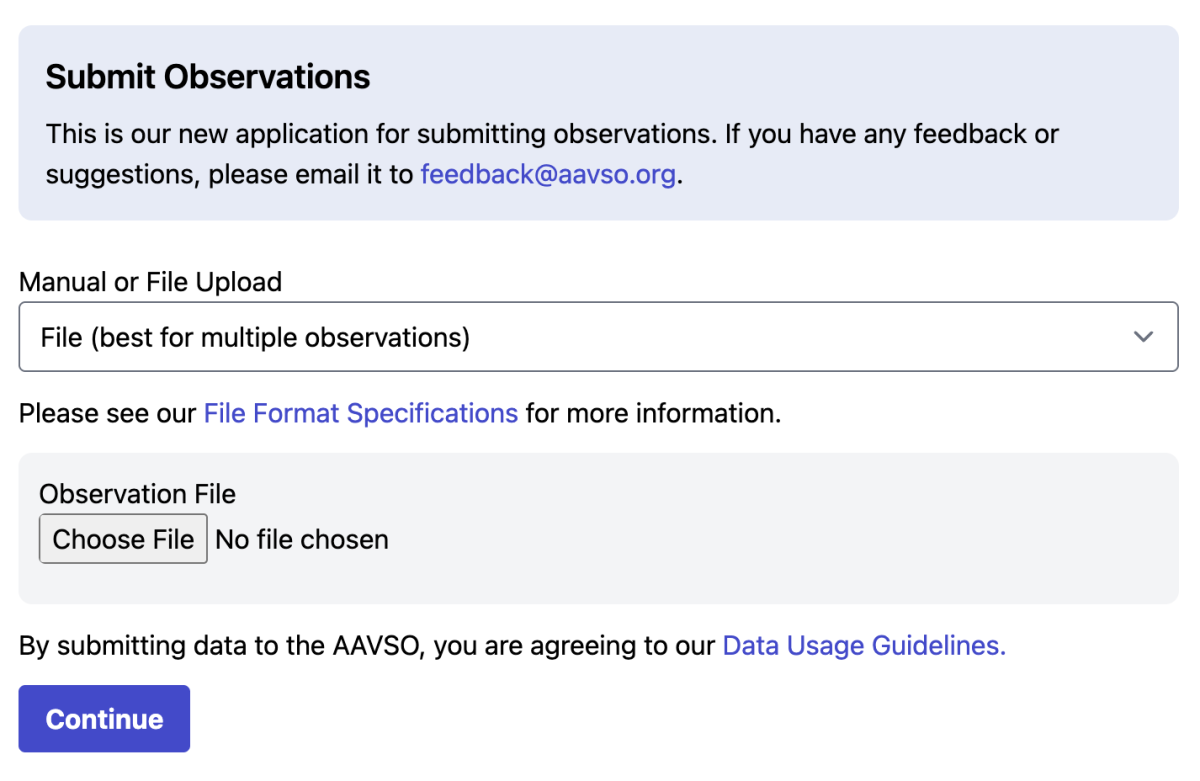
Dear AAVSO Observers,
I am writing to let you know that the way you submit photometric data to the AAVSO is changing. The existing WebObs application on www.aavso.org will be officially retired on June 6, 2025. It has been replaced by WebObs 2.0, a new photometric data submission application available at apps.aavso.org. If you have not already done so, we encourage you to begin using the new application immediately.
WebObs has long been a core application within the AAVSO. It was originally developed by Aaron Price in 1999 as a standalone Perl and PHP application. In 2003, AAVSO’s first dedicated web developer, Will McMain, integrated it into AAVSO’s main website. In 2008, we expanded its functionality to support the AAVSO Visual File Format, followed by support for the AAVSO Extended File Format for digital detectors in 2010. Since then, aside from minor bug fixes and occasional updates to remain compatible with newer versions of Drupal, the application has remained largely unchanged.
Unfortunately, maintaining the technical infrastructure that supports WebObs – and the primary website at www.aavso.org – has become prohibitively expensive. Since 2017, the AAVSO has relied on third-party contractors at a cost of $30,000 to $75,000 per year, to apply updates and keep the system running securely. This high cost is largely due to an aging technology stack with fragile dependencies in PHP, Bash, Perl, and several other scripting languages that frequently break when things are updated. I hope you would agree with me that this approach is not sustainable.
To address these challenges, the AAVSO adopted a new technical strategy in 2023. We began transitioning to commercial off-the-shelf software for standard functions such as our website, forums, authentication, donation processing, and membership management. Custom software development is now reserved for tools that are truly central to our scientific mission. While some work remains, this transition has already lowered operational costs, improved system performance and uptime, and allowed headquarters staff to refocus on supporting the core work of the AAVSO community.
WebObs is the last remaining tool on our legacy system that must be replaced before we can move forward with a full transition of the website itself.
The WebObs 2.0 application has been in public beta since March 2025 and has undergone testing with some of our most active observers. All known issues identified during testing have been addressed. The application is ready to go. I would like to extend my sincere thanks to Tom Calderwood, George Silvis, Josch Hambsch, Gary Walker, and many others for their valuable feedback and thoughtful suggestions.
There are a few key differences with WebObs 2.0 that I’d like to highlight.
- Data comparison plots: The new system now displays your submitted data relative to other recent observations of the same star. This feature, recommended by the Data Quality Taskforce, is intended to encourage you to look at your data before officially submitting it to the AID. Stars with potential issues are flagged in red based upon a 5-sigma threshold. Despite testing with numerous approaches, we found this method to be the most reliable across a wide range of variable star types.
- Observer totals: Observer totals are no longer displayed within WebObs. Instead, this information is now available in a new analytics dashboard, which provides a summary of your total photometric observations and data downloads. The dashboard is updated nightly.
- Upload permissions: We have discontinued support for uploading data on behalf of other observers. If you previously had this capability and are impacted by the change, please contact AAVSO Headquarters to discuss your situation.
- Submission limits: All other submission policies—including file size limits, date range restrictions for old data, and related constraints—remain unchanged.
Thank you for your continued contributions and commitment to advancing variable star science.
If you encounter any issues with the new application, please post on this forum thread. Likewise, if you would like us to put together an instructional video on the changes, please let us know in that thread. We’re here to help if you have any questions during the transition.
Dr. Brian Kloppenborg
Executive Director
American Association of Variable Star Observers
Email: bkloppenborg@aavso.org

